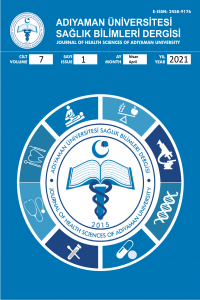Kuduz şüphesiyle acil servise başvuran olguların incelenmesi
Kuduz, Kuduz Profilaksisi, Şüpheli Isırık
Analysis of the cases with rabies fears admitted to emergency service
Rabies, Rabies prophylaxis, Suspected bit,
___
- 1. Dede T, Kocabaş E. Dunyada ve Ulkemizde Henuz Cozulmemiş Bir Halk Sağlığı Sorunu: Kuduz. Journal of Pediatric Infection. 2008;3 109-116.
- 2. Rupprecht CE, Hanlon CA, Hemachudha T. Rabies re-examined. Lancet Infect Dis 2002; 2: 327- 343.
- 3. Wyatt J. Rabies-update on a global disease. Pediatr Infect Dis J. 2007;26:351-352.
- 4. Knobel DL, Cleaveland S, Coleman PG, Fèvre EM, Meltzer MI, Miranda ME, Shaw A, Zinsstag J, Meslin FX. Re-evaluating the burden of rabies in Africa and Asia. Bull World Health Organ. 2005;83:360.
- 5. American Academy of Pediatrics. Rabies. In: Pickering LK (ed). Red Book 2006: Report of the Committee on Infectious Diseases. 26th ed. Elk Grove Village, III: 2006;552-559.
- 6. Doe J. Human rabies prevention-United States, 1999: recommendations of the Advisory Committee on Immunization Practices (ACIP). MMWR Recomm Rep. 1999;(1):214.
- 7. Dumandan AD. Kuduz aşıları. Türkiye Klinikleri Pediatri Özel (Aşılar Özel Sayısı). 2004;2:1024-1031.
- 8. Temel Sağlık Hizmetleri Genel Müdürlüğü Çalışma Yıllığı 2003 Ankara: Sağlık Bakanlığı Yayınları 2004, s.105.
- 9. T.C.Sağlık Bakanlığı Temel Sağlık Hizmetleri Genel Müdürlüğü Kuduz Korunma ve Kontrol Yönergesi. (http:// www.saglik.gov.tr/SHGM/belge/1-15918/kuduz-korunma-ve- kontrol-yonergesi.html)
- 10. Rabies Fact sheet No 99 Accessed September 28, 2011, at (http://www.who.int/mediacentre/factsheets/fs099/en/)
- 11. Göktaş P, Ceran N, Karagül E, Cicek G, Ozyurek S. Kuduz Aşı Merkezine Başvuran 11,017 Olgunun Değerlendirilmesi. Klimik Derg. 2002;15:12-15.
- 12. Yıldız M, Durukan P. Hayvanlara Bağlı Yaralanmalar: Fırat Tıp Derg. 2005;10:25-26.
- 13. Dodet B, Goswami A, Gunasekera A, de Guzman F, Jamali S, Montalban C, Purba W, Quiambao B, Salahuddin N, Sampath G, Tang Q, Tantawichien T, Wimalaratne O, Ziauddin A. Rabies Awareness in Eight Countries. Vaccine 2008;26:6344-6348.
- 14. Söğüt Ö, Sayhan MB, Gökdemir MT, Kara HP. Türkiye’nin Güneydoğusunda Önlenebilir Bir Halk Sağlığı Sorunu: Kuduz Riskli Temas Olguları. JAEM 2011;1:14-17.
- 15. Temiz H, Akkoç H. Diyarbakır Devlet Hastanesi Kuduz Aşı Merkezine Başvuran 809 Olgunun Değerlendirilmesi. Dicle Tıp Derg. 2008;35:181-184.
- 16. Rabies Epidemiology. Accessed December 28, 2011, at http://www.who.int/rabies/epidemiology/eng
- 17. Sengoz G, Yaşar KK, Karabela SN, Yıldırım F, Vardarman FT, Nazlican O. Evaluation of cases admitted to a center in İstanbul, Turkey in 2003 for rabies vaccination and three rabies cases followed up in the last 15 years. Jpn J Infect Dis 2006;59:254-257.
- 18. Moran GJ, Talan AD, Mower W, Newdow M, Ong S, Nakase JY, Pinner RW, Childs JE. Appropriateness of rabies postexposure prophylaxis treatment for animal exposures. JAMA. 2000;28:1001-1007.
- 19. Fishken DB, Bernard KW. Rabies virus. In Mandell GL,Bennett JE, Dolin R (eds): Mandell, Douglas and Bennett’s Principles and Practice of Infectious Diseases. 4th ed. NewYork. Churchill Livingstone 1995, pp:1527-1543.
- Yayın Aralığı: Yılda 3 Sayı
- Başlangıç: 2015
- Yayıncı: ADIYAMAN ÜNİVERSİTESİ
Subkutan venöz port katater uygulamalarımızın değerlendirilmesi: 6 yıllık klinik tecrübemiz
Koronavirüs enfeksiyonları ve yeni düşman: COVID-19
Meslek yüksekokulu öğrencilerinin meme kanserine ilişkin inanç ve tutumları
Acil serviste tüp torakostomi uygulanan hastaların sonuçları
Akut ı̇skemik serebrovasküler olayda trombosit ı̇ndekslerinin tanısal değerinin ı̇ncelenmesi
Mustafa BOĞAN, Yılmaz SAFİ, Mehmet Murat OKTAY, Mustafa SABAK, Hasan GÜMÜŞBOĞA
Farklı prezentasyon gösteren iki vaka; 1p 36 delesyon sendromu
Hilal AYDIN, İbrahim Hakan BUCAK, Mehmet GEYİK, Haydar BAĞIŞ
Ameliyathane hemşirelerinin kanıta dayalı uygulamalar hakkındaki bilgileri
İrem AKDEMİR, Ezgi KARADAĞ, Neriman AKANSEL
İmplant planlamasında iki farklı görüntüleme yönteminin karşılaştırılması
Serap KESKİN TUNÇ, Mehmet GÜZEL
Hemodiyaliz tedavisi alan kronik böbrek yetmezliği hastalarının yaşam deneyimlerinin incelenmesi
